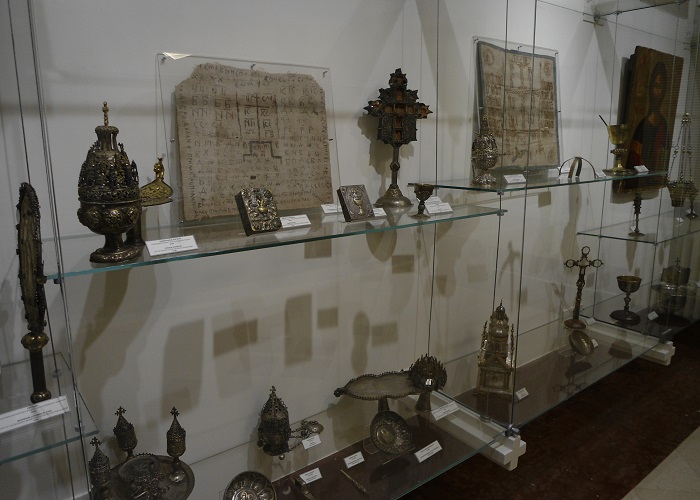A few days ago I tried my routine again and a man dressed in a crisp business suite rather than a priest’s robe declared in an authoritative voice “The Museum is open…You need to enter from the door opposite St Michael’s Cathedral.“ Without saying thank you I ran off to the other side of the same building and excitedly pressed a heavy door, pushing it with my whole body and almost falling into what was a garage once upon a time and today was a well-polished entrance hall still smelling of paint. The floor was set in three different colours of marble with distinctive artwork in the shape of circles, something you find in Serbian churches built nowadays. After purchasing a ticket we walked towards the heavy stairs that led us to the museum itself on the first floor. The first impression was disappointing. It was a long hall decorated with framed letters, notifications, portraits of church dignitaries, and old photographs from Serbia’s rich past. We walked through very quickly thinking, is that it? At the end of the corridor a lady, dressed in blue, maybe a uniform, walked in front of us and disappeared into a room on the right. I heard her unlocking the door, switching the lights on and her rubber shoes squeaking through the empty building, she disappeared where she came from. Dispirited and ready to go back we secretly peeked through the door where the lights came from and we stood silent, shocked with the amount of the history laid bare in front of us. The loud and honest “WOW” made a lady who opened a door chuckle behind us. Adrenalin and frustration at not being to see the Museum for such a long time kicked in and I started running around trying to see everything at once. Then realising the Museum is not that big only very rich with exhibits I calmed down and started to follow some kind of pattern.
Liturgical books decorated in gold, silver and precious stones dating back from XIV century, the shroud of King Milutin dating from end XIII or beginning XIV c, a silver reliquaries chest dating from XVI c, the sermons of St Isaac of Syria, XIV c, a huge icon of wood, the Adoration of the Wise Men from XVII c, Byzantium crosses and seals, chalices, old sacred vessels, various donations, icons, are squeezed into three connected rooms. Each display had an explanation written in Serbian and English showing the development of the Serbian Orthodox Church through the centuries. Most of the exhibits come from monasteries scattered around Fruska Gora, from churches around eastern Srem and from donations.
Textiles have a significant presence in the museum and two very interesting pieces of history are the gown of Prince Lazar dating back to 1389 which is the year of the battle of Kosovo, and a shroud made by the nun Jefimija who is regarded as the first Serbian poetess.
The Museum and the richness of the exhibits are of the standard of the exhibition held in London at the Royal Academy of Art, titled Byzantium. The only difference is that you don’t have to queue here in Belgrade and the entry tickets are much more affordable. This may change as the Museum of the Orthodox Church of Serbia is just recently opened.
Address: Kralja Petra nr. 5, entrance from the street Kneza Sime Markovica 6
Open: Weekdays 9-16h, Saturdays, Sundays and Religious Holidays the Museum is Closed
Entrance fee: RSD400 (approx US$5 as per 20th January 2014).
For more information about things to see and do in Belgrade of independent day tours in Belgrade please email Tara@ReadyClickAndGo.com or visit specialist website for day tours, day trips, city tours, travel experiences at www.ReadyClickAndGo.com












